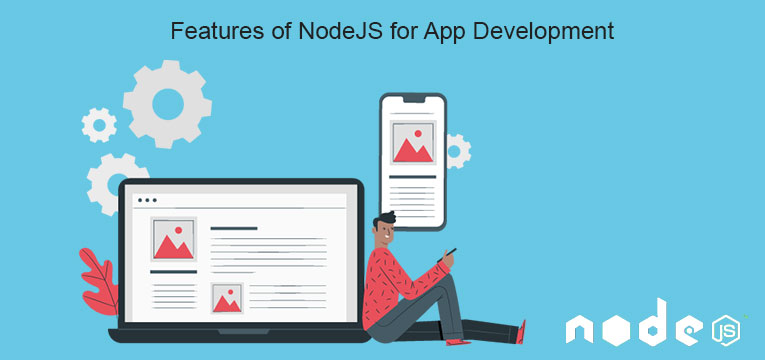Table of Content
Improved Features of NodeJS v14 for Application development
If someone says to me JavaScript is the most popular and widely used client-side programming language, hands down! There is no debate about it and with the emergence of NodeJS 14 – NodeJS development realm seems to have gone to the next level.
The journey from being just a mere front-end development tool to now being a building cross-development platform, the tech now seems to have grown and become more than handy. Also, one cannot ignore how NodeJS development is widely being blended with other popular platforms such as React Native, PhoneGap, Titanium, Apache, NativeScript, Appcelerator and so more.
NodeJS
More often known as the right technology stack, NodeJS tops it all in regards to scalability, learning curve, speed of development, community and the list goes on. One of the most inspiring lines reads- Those things which cannot be avoided must be adopted; and it turns out to be cent percent true for NodeJS technology.
Built on V8, NodeJS is a cross-platform runtime environment featuring a high-performance, open-source Javascript engine. With the strong application of event-driven, non-blocking I/O paradigm, the tech seems to have gained momentum to a great extent.
In simple words, if you aim to build fast, scalable network applications consuming real-time information, look no further than a reputable NodeJS development company offering high-end performance, faster development, and several other perks. What else can we have with NodeJS?
Real-time web applications like Chat programs, collaboration tools, API, Social media apps, virtual emulators, Streaming applications, Messaging apps, multiplayer games, and the never-ending list goes on!
NodeJS v14 major Advantages
- Easy Scalability and Flexibility – Scaling all the upcoming applications in both horizontal, as well as vertical directions now, becomes doable; most importantly easy. In addition, NodeJS developers during the vertical scaling of the application do get the liberty of adding extra resources to the single nodes. On and all, in comparison to other javascript servers, it turns out to be the best.
- Easy Adoption – Other than scalability, NodeJS development is way easier in regards to learn and adopt. And the best part here is, there is no steep learning curve which means those who have mastered JavaScript and Object-Oriented Programming basics; it’s good to go for them. Of course, everything here cannot be that easy Node’s asynchronous flow could be a hitch. Fortunately, you will find plenty of information (tutorials, interactive courses, Github) on the internet and NodeJS development companies who can assist you in delivering a pleasant experience.
- High Performance – We all know that the technology interprets the JavaScript code via the Google V8 JavaScript engine. Without much hassle, you will see the compilation of JavaScript code directly into the machine code. As a result, implementing code becomes way faster and easier in an effective manner. Due to its support for the non-blocking I/O operations, the speed of the code execution now seems to be enhanced by the runtime environment.
- MVP Development – 2020 is the year for shirt budget and strict timelines. So what the least we can consider is rapidly approving the attractiveness of the product’s idea with the least endeavors, speculations, and assets so you are guaranteed that the product is generally welcomed before paying out more cash on improvement.
- Active and Large community – Much like other technologies, NodeJS is privileged to have a large and active community of developers who keep on the continuity to develop and improve. Several tools and decent instruments such as NPM (Node Package Manager/ Node Package Ecosystem) are there featuring numerous libraries and reusable templates that can be hassle-free incorporated in the code to have more value with less effort and time. To be precise, the NPM system comprises several modules for pretty much anything one can imagine.
Meet NodeJS Version 14
NodeJS 14 has got some improved features like improved diagnostic, experimental Async local storage API, an upgrade of V8, hardening of the streams APIs, removal of experimental modules and some more.
With the dawn of 2020, NodeJS turns 10 years old and its downloads seem to rise 40% or more every year and this is showing no signs of slowing down. The 14 version replaces 13 but v10 and v12 will have long term support until 2022 and 2021 respectively.
NodeJS developers, you don’t have to worry because as for NodeJS 12 and 10 they aren’t going anywhere as they will remain long-term support until April 2022 and 2021 respectively.
Improved features of NodeJS version 14
Get Rid of Experimental Modules Warning
If you could remember there was a time when the entire realm was set to incorporate the experimental-modules flag in version 13. Experimental warning about EcmaScript Modules loader shown.
With NodeJS 14, there is no warning required while using ESM. However, the application of ESM does stay experimental for example the feature is not subjected to Server rules. In the new release Non-backward alteration can happen and developers need to keep an eye on that while application development.
The EcmaScript Modules can behave differently than the experience you have. Features like JSON modules, optional file extension is now supported in Transpilation workflows.
Transpired environments modules for working in NodeJS required refactoring. Design decisions were Web Compatibility and Spec Compliance.
In NodeJS, the ESM will not be experimental very soon and experimental warning will be removed.
Async Local Storage API
Do you know how web servers run PHP for website hosting? We hope you do, now since we have limited time let’s get to the point. Your web server ensures to spin off a new thread, the moment it receives a request from a client.
With the help of that thread all resources, call stack functions and local variables can be managed but not in case of JavaScript.
Even NodeJS is single-threaded you may ask? Well, it is and that’s where this Async local storage takes place; it comprises variables and functions local to a particular thread, especially for handling a particular user on the webpage.
Over a number of releases, the project has been considering APIs so that they can manage context across Asynchronous calls. In earlier versions Async Hooks API was present and is experimental.
In order to address this need APIs provided by many npm modules but maintaining the outside of NodeJS core was difficult.
Upgraded to Version 8.1 (V8 Engine)
Right from optional chaining to Nullish coalescing, enabling of the calendar, and numbering System, the new V8 JavaScript engine offers such serious performance tweaks and improvements. Let’s delve into details:
- Optional Chaining – Validation of each reference in the chain is now not required.
- Intl.DisplayNames – Language consistency along with region and names translation.
- Intl.DateTimeFormat – With V8 engine calendar option along with numbering system has been added
Diagnostic Report: Stability like never before
Another good news for NodeJS developers is the Diagnostic Report being officially added as a stable feature. Before you ask what a Diagnostic report is, it provides user-consumable reports featuring relevant information on debugging and triaging issues within a production environment. So what is this report capable of? Right from identifying incorrect output to abnormal termination, slow performance, High CPU usage, Unexpected errors, memory leaks, this feature offers it all. npm was used to install the Diagnostic report and was earlier available in the npm module.
npm install node-report
As soon as you install, you will be able to trigger a report via an API such as
var nodereport = require(‘node-report’);
nodereport.triggerReport();
One of the most interesting aspects here is that you no longer have to install node-report as the functionality is built within the technology. A report can be generated within the application in regards to fatal errors or single-line JSON format, sets signal for report generation and so more.
Experimental Web Assembly System Interface (WASI)
With this element cross platform support, native modules usage and performance can be enhanced.
Platform Minimums + New Compiler
This one is quite known that Node provides pre-built binaries for a wide range of platforms. In addition, the minimum toolchains are assessed and raised for each major release.
Streams APIs seem Different
With an objective to improve consistency across the Streams APIs, it offers numerous changes such as:
- http.OutgoingMessage is similar to stream.Writable
- net.Socket behaves exactly just as stream.Duplex.
- autoDestroy option is set ‘true’ by default and makes stream always call _destroy after ending
Conclusion
Although it’s in its present stage for the next six months NodeJS 14 is expected to get the newest features like never before. Are you ready for that? We being a reliable NodeJS development company might want to ensure the infrastructure to create and test releases and make the essential moves up to our toolchains for NodeJS 14 and offer significant data and updates. Connect with us now with your NodeJS requirement.
Being an intuitive server-side scripting language, PHP has been in talks since its establishment in 1944. With the time passing by and due to regular...
 Aug 8, 2020
Aug 8, 2020 




NodeJsv14 includes immensely beautiful features. Thanks for sharing it though.
NodeJs V14 provides ravishing new features like high scalability and flexibility with many more unique improvements.
Thanks for sharing this post. It is helpful for checking out the project’s compatibility with the latest updates of Node.